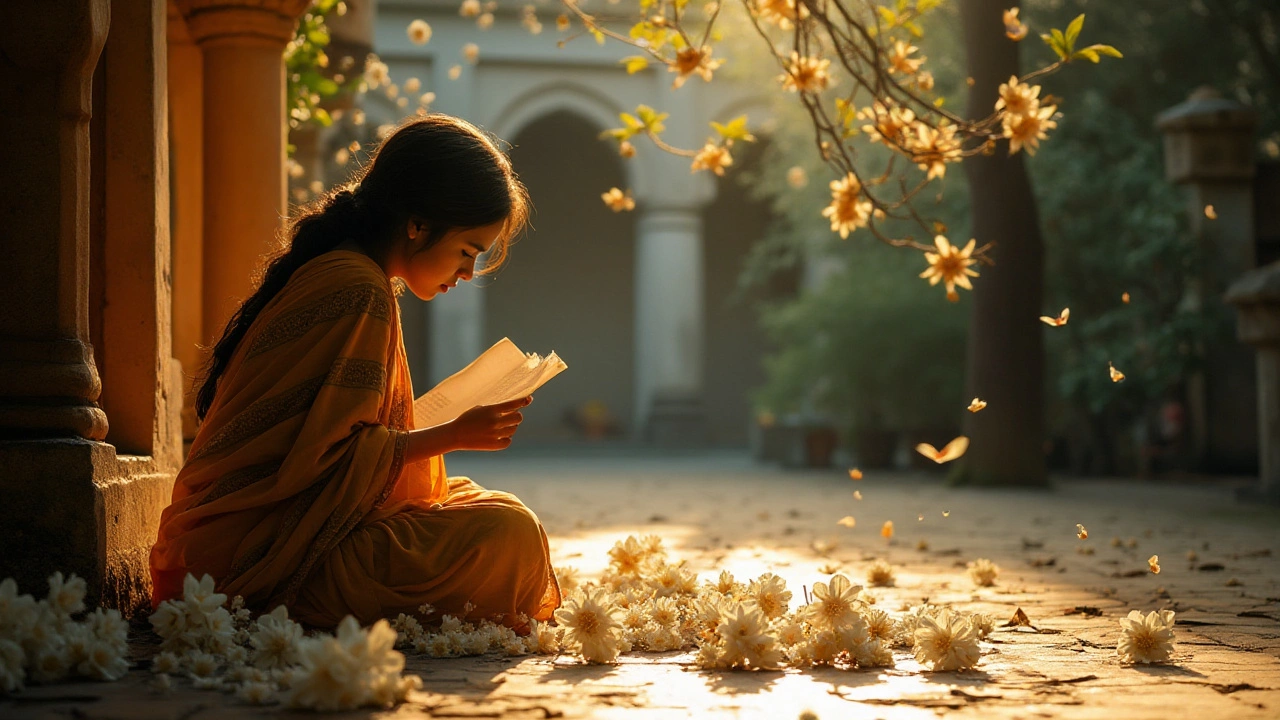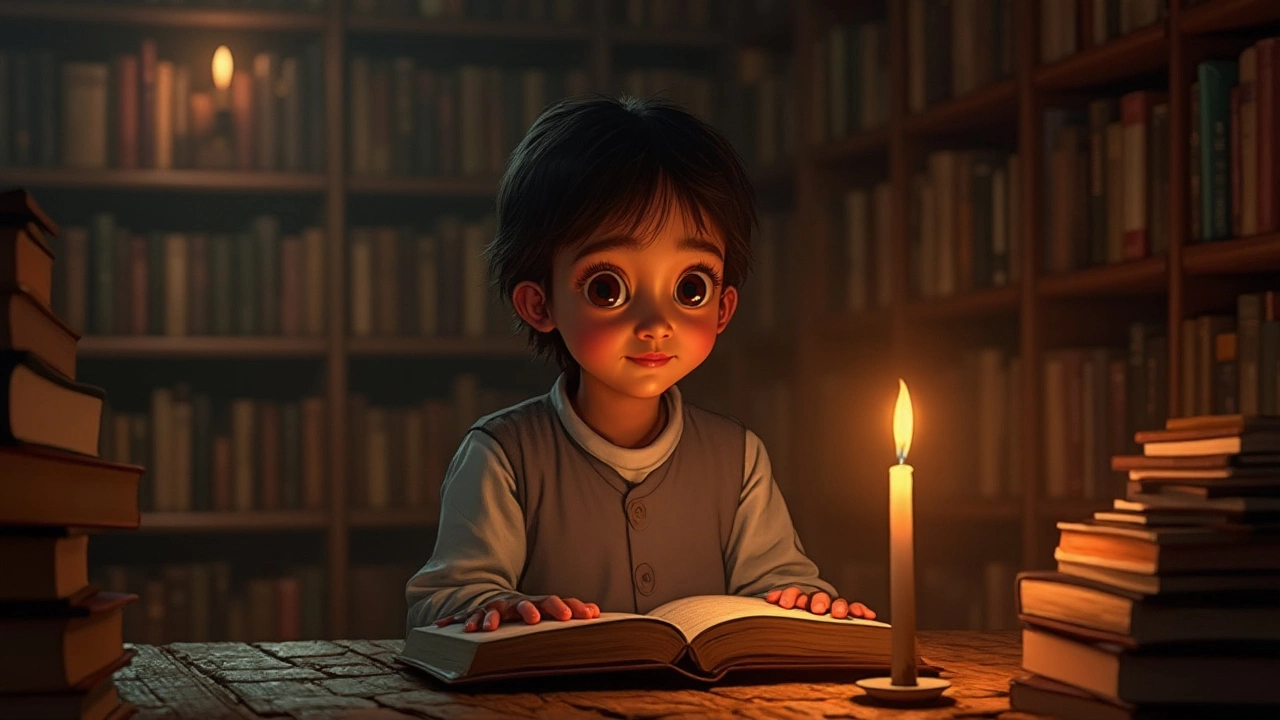
Few experiences in life are as universal and deeply personal as a broken heart. It's a journey many of us must take at some point, yet it never feels less harrowing when it's our own. While time is often touted as the ultimate healer, poetry has long offered an immediate salve, providing comfort and understanding amid the chaos of emotions. Words possess a transformative power, allowing us to feel seen and heard even in solitude.
Sad poetry, in particular, provides a unique channel for expressing the turmoil that accompanies heartbreak. It’s where raw emotions meet art, creating something beautiful from pain. The poems crafted in moments of sorrow serve not just as an homage to our own experiences but become shared experiences, resonating with others who have known similar depths of heartache.
Throughout history, poets from India and around the world have woven their tales of heartbreak into lyrical masterpieces, using symbolism and simplicity to portray complex emotions. By exploring these rich traditions of sad poetry, we open ourselves to healing, understanding, and ultimately, hope. In the eloquence of verses, we find a piece of ourselves reflected and affirmed.
- The Healing Power of Poetry
- Voices from the Heart
- Symbolisms in Sad Poetry
- Indian Poets and Heartbreak
- Finding Comfort and Closure
The Healing Power of Poetry
Poetry has an innate ability to reach into the depths of our emotions and bring them into the light. This art form, stretching back to ancient times, allows us to process our feelings, make sense of heartbreak, and discover pathways toward healing. Whether crafted from the simplicity of Haikus or through the intricate verses of Ghazals, poetry has consistently served as a balm for wounded hearts. As we align our innermost pain with sad poetry, the rhythm and flow of words start to stitch together the raw edges, offering a sense of solace and understanding. When life's trials seem too immense to verbalize, poetry steps in, acting as a companion in our solitude.
By acknowledging emotions in a structured yet liberating way, poetry grants us cognitive relief, permitting the nuanced feelings of a broken heart to free themselves from the confines of the psyche. This becomes an expressive outlet, allowing one to look beyond the immediate anguish and view the situation from a new, often enlightening perspective. Furthermore, renowned poets such as Rupi Kaur and Rabindranath Tagore have used their poignant words to demonstrate the transformative impact poetry can have on individuals facing personal upheaval.
Words as Companions Through Heartbreak
Depicting emotion through poetry is akin to having a conversation with someone who truly listens. The act of reading or writing poetry offers a chance to verbalize pain, to transform feelings into something tangible and manageable. This process can be therapeutic, acting as an impetus for introspection and reflection. It’s about gaining clarity through the poetic narrative. A study once revealed that engaging with poetry can significantly decrease anxiety and promote emotional well-being, demonstrating its potential as a healing art."Poetry is emotion put into measure. The emotion must come by nature, but the measure can be acquired by art." — Thomas Hardy
At the heart of poetry's efficacy is its capacity for universality; it resonates across cultures and generations, with each reader finding their own reflection in the words. As poets articulate what seems inexpressible, they offer a shared experience and validation to those who feel similarly—but may not yet have the ability to articulate it themselves. Consequently, sad poetry not only allows us to express our emotional state but also connects us with others who have trodden similar paths under the burden of heartache.
Creating Connections and Finding Understanding
The emotional resonance found in the lines of sad poetry often leads to deeper connections with oneself and with the wider world. Providing a window into personal reflections, poetry often resonates with readers in profound ways, allowing a communal sense of empathy to emerge.| Percentage of People | Find Poetry Therapeutic |
|---|---|
| 70% | Yes |
| 30% | No |
Voices from the Heart
In the delicate realm of a broken heart, few things capture the essence of what we feel better than words strung artfully together. This is where sad poetry emerges as a powerful ally, channeling sorrow into an art form that resonates deeply with those who read it. What makes these verses so compelling is not just the skill of the poet, but the universal truths they touch upon. Poets serve as voices for emotions we sometimes struggle to articulate, bringing clarity to the chaos within us.
The words in sad poetry often feel as though they echo directly from the heart of the writer, providing us with a window into their soul while reflecting our own feelings back at us. This connection across time and space is part of what gives poetry its healing power. The human experience of heartache is timeless, a common thread woven into the fabric of our existence, uniting strangers through shared experiences. In India, for instance, the rich tradition of shayari and ghazals – poetic forms deeply rooted in expressing longing and love – have long served as a means for hearts to voice their sorrow.
Famous Poets and Their Influence
Take the works of Mirza Ghalib, for instance. His ghazals poignantly express the agony and beauty of love lost, capturing the fleeting nature of happiness. Ghalib's words transcend the era in which they were penned, speaking to the timeless nature of human emotion. The layers of sentiment in his verses draw readers into a shared introspection. Similarly, poets like Faiz Ahmed Faiz have etched their feelings into the tapestry of language, leaving behind legacies of melancholic beauty. These poets provide an invaluable service; they create a sanctuary for sorrow, a place of understanding that guides many through their darkest days.
"The wound is the place where the Light enters you." - Rumi
Sad poetry gives voice to unspoken thoughts, encouraging readers to accept their pain as an integral part of their healing process. When poets externalize their inner turmoil, they don't just document personal emotions; they universalize the human condition. This leads to healing, fostering empathy and allowing those who partake in these literary pieces to feel less isolated in their grief. In the act of sharing their heart’s voices, poets invite us to acknowledge and honor our own emotions. The words offer solace, not by promising the disappearance of pain, but by validating our feelings and experiences, helping us navigate our emotional landscapes.
Poetry's enduring appeal lies in its capacity to echo the whispers of the heart, making it an art form that remains eternally relevant, especially during times of sorrow. For those who seek comfort amid heartbreak, turning to the written word can be both a refuge and a revelation.

Symbolisms in Sad Poetry
Sad poetry is a realm where emotions are not just expressed but are also adorned with rich symbolism that adds layers and depth to the verse. Effective use of symbols transforms mere words into powerful and vivid imagery, encompassing the essence of heartbreak. A broken heart is often conveyed through the symbolism of shattered glass, capturing its fragility and the difficulty of mending once it is broken. These images are not accidental; they are deliberately chosen to engage the reader's senses and evoke empathy and understanding. In essence, the symbolism acts as a bridge between the poet's inner turmoil and the reader's potential shared experiences.
Nature often plays a profound role in sad poetry, where changing seasons, particularly autumn, represent fading love or loss. Autumn, with its shedding leaves, acts as a metaphor for letting go, a poignant reflection echoed in the rhythm of poetry. Water, too, serves as a powerful symbol, representing tears and the endless flow of sorrow, yet it also signifies cleansing and renewal, hinting at eventual healing. Through these symbols, poets convey complex emotions simply and accessibly, allowing the reader to see their pain mirrored in another's words, and by doing so, find solace in shared humanity.
| Symbol | Meaning |
|---|---|
| Autumn Leaves | Letting go, transition, endings |
| Shattered Glass | Broken heart, fragility |
| Water | Tears, renewal, continuation |
Traditional Indian poetry, infused with its own cultural and mythological symbols, often infuses familiar motifs such as the lotus. The lotus, rising from murky waters, serves as a symbol of purity and resilience, reminding us of strength amidst adversity. Peacocks, with their vibrant feathers and iconic dance, often symbolize longing and unfulfilled desires, their haunting calls echoing through verses much like the cries of a pained heart. These cultural symbols enrich the poem's narrative, anchoring deeply personal sentiments with a local, evocative resonance. They invite the reader to explore not just the sorrow but also the beauty and hope intertwined within painful experiences.
"Poetry is an echo, asking a shadow to dance," said Carl Sandburg, encapsulating how poems reflect our innermost feelings through the delicate dance of words. Sad poetry, in particular, uses symbolism to echo the heart's deepest agonies while offering a shadow of hope. The symbols dance across the page, invoking thought and emotion, urging readers to contemplate their own journey through heartache and healing.In crafting sad poetry, the careful selection of symbols often marks a poet's creative ingenuity. These symbols become the steady handhold for readers navigating the rocky terrains of emotion. As they decipher the layers of meaning, readers find meaning and connection woven into the fabric of the poem. Thus, symbolism in sad poetry is not merely decorative; it is transformative, breathing life into words and breathing empathy into the reader's experience with heartbreak.
Indian Poets and Heartbreak
India has given birth to some of the most evocative and profound poets who have candidly expressed the raw intensity of a broken heart through their works. These Indian poets have not only explored love’s many nuances but also the pain and disillusionment that often accompany it. Mirza Ghalib, for example, is renowned for his ghazals that eloquently depict the depths of longing and heartbreak. His words manage to encapsulate the very essence of melancholy and yearning, capturing feelings that resonate with anyone who has loved and lost. The timeless appeal of his poetry continues to touch hearts, each verse lovingly wrapped in the comforting cadence of Urdu.
Rabindranath Tagore, another towering figure in Indian poetry, approached heartbreak with a philosophical lens. His exploration of sorrow wasn't limited to romantic disillusionments but extended to the broader human experience of love and loss. In his works, Tagore often invites readers to find solace in nature and spirituality, seeking a profound understanding of human emotions. Such poetry serves as a reminder that while heartache is deeply personal, it is also a shared human experience, transcending cultural and temporal boundaries.
The heart-rending poetry of Sahir Ludhianvi reflects both personal and socio-political heartbreaks. Known for his use of stark and powerful language, he has captured the bareness of unrequited love and the agony of societal factors that distance lovers. Ludhianvi's poignant verses often urge introspection and evoke a deep emotional response in the reader. When his words talk of lost connections, they are layered with an understanding of love's complexity in the face of societal challenges.
The modern Indian poetic scene is just as rich, with poets like Javed Akhtar carrying forth the legacy of expressing broken hearts through poetry. Akhtar's works resonate with contemporary audiences, discussing themes of love, heartache, and hope in a globalized world. His poetry beautifully addresses the multidimensional nature of heartbreak, evoking empathy and solidarity among readers who find their own experiences mirrored in his verses.
“Love is fragile, and heartbreaks are inevitable, but poetry molds these fragments into ageless stories.” - An ancient adage that rings true when we delve into the world of Indian poetry.
Through the words of these great poets, heartache transforms from a solitary burden to a shared narrative, linking us across time and space. This literary tradition assures us that even the deepest pains have been felt, expressed, and ultimately, woven into the cultural fabric that binds humanity. Truly, sad poetry is a testament to the resilience of the human spirit, a cherished vehicle for understanding and healing.

Finding Comfort and Closure
For many, the path to healing a broken heart lies in finding both comfort and closure, crucial steps in transcending the initial pain that can seem insurmountable. Engaging with sad poetry can be both cathartic and illuminating, providing the comfort needed to mend emotional wounds. When we read the profound words of poets who have beautifully articulated the most turbulent of feelings, we often find a sense of shared experience, as if someone has reached out across time and space to hold our hand in solidarity. Poems echo the universal struggles of love and loss, their verses becoming stepping stones towards acceptance and inner peace.
In seeking closure, it's essential to acknowledge that healing is not a linear journey. Diverse expressions in poetry illuminate that every person's path is unique, shaped by individual experiences and emotions. Voices from the heart within these poignant pieces remind us that lasting emotional recovery often necessitates embracing the painful memories rather than burying them. Renowned poets have turned to nature, history, and spirituality to illustrate this point, reminding us that healing, like the rhythmic cycle of seasons, requires patience and perseverance.
Take, for instance, the timeless verses of Rabindranath Tagore, whose work often juxtaposes love and solitude to explore the intricacies of the heart. His writing emphasizes purity and transparency of emotion while maintaining a profound connection to the inner self. He once captured the essence of moving forward through acceptance with words that resonate across generations—not as walls that confine but as doors that open to new beginnings. In these verses, readers may uncover layers of relief, knowing that closure leads not to forgetting, but to a transformative understanding of personal growth and resilience.
“It is very difficult to live among men because silence is so difficult.” ― Rabindranath Tagore
In practical terms, finding comfort and closure in sad poetry can be made more tangible by creating spaces dedicated to reflection and creation. Starting a journal of personal responses to poems or compiling a collection of comforting reads can provide solace during moments of grief. Sharing these reflections in a communal setting, whether with friends, online platforms, or local poetry clubs, can also be immensely healing, encouraging dialogue and fostering connections.
Lasting closure often necessitates a change in perspective. When we allow ourselves to view heartbreak not as an end, but as an evolution of self, we uncover the liberating truth that life continues to offer joy and love. Solace lies in embracing impermanence and appreciating the transient beauty of each moment as poetry teaches us to do. In this way, once elusive comfort and closure become attainable, opening new doors to life's myriad possibilities.